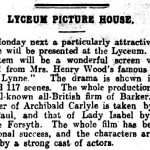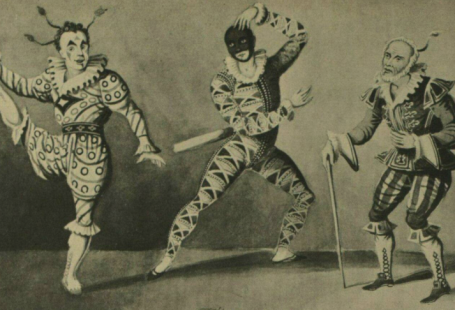
The Premiere of Sherlock Holmes
What better way to ring in the New Year than with the premiere of the latest series of the BBC’s Sherlock?
The hype generated by this latest iteration of the famed ‘consulting detective’ is far from unprecedented. From the first appearance of the sleuth at 221B Baker Street, audiences have been glued to the page and eager for more.
Sherlock Holmes first graced the pages of Beeton’s Christmas Annual in the 1887 printing of A Study in Scarlett. The novel was printed as a serial to great success.


On the heels of its success, it wasn’t long before Arthur Conan Doyle had a new Sherlock story. The Sign of Four came out in 1890.

You can read the serial installments of The Sign of Four in the Hampshire Telegraph on The British Newspaper Archive.

It’s important to remember that before radios and televisions became ubiquitous in homes, newspapers were a primary source of both news and entertainment. You can imagine the anticipation felt as people waited for the latest installment of a serial. Friends and family may have even gathered together to read aloud the latest chapter of a Sherlock Holmes mystery – the nineteenth century version of live tweeting about the latest Sherlock episode!
Fully serialised stories like those of Sherlock Holmes played a role in the readership of a newspaper. The enticement of a new chapter being printed kept readers coming back to the paper, creating a loyal following of subscribers. Seralised stories would often be subsequently printed as stand-alone novels, often broken up into several volumes.

History of serial literature in newspapers
Victorian England saw a rise in literacy, coupled with advances in both printing and distribution, which resulted in the rapid growth and popularity of seralised fiction. Printing installments in newspapers was less costly than publishing entire stand-alone novels and was more economical for readers.
The success of Charles Dickens’ The Pickwick Papers, first printed in 1836, is credited with proving the potential and appeal of seralised literature. As authors were paid by line and installment, novels of the era were particularly lengthy.
A voracious readership put pressure on authors to write more and faster to provide additional installments. As you can imagine, not all authors flourished under such conditions. Others, however, did – Alexandre Dumas found great success in writing serial fiction and could write upwards of 14 hours a day.
Serial fiction started its slow decline with the growing success and availability of broadcast radio and television. As broadcast took on the role of entertainment, newspapers shifted to focus more exclusively on news. The serial publications that did continue into the 20th century were received with mixed reviews.
Sherlock’s enduring legacy
The appeal of Sherlock Holmes endured past the pages of such newspapers as The Strand and met with equal success as printed books and, later, on the small and big screens. But the devotion extended even further: seventy-one years following the debut of A Study in Scarlet—and twenty-eight years after Sir Arthur Conan Doyle’s death—there was opened a public house in London dedicated to Sherlock Holmes. The public house ‘contains a fascinating museum of exhibits and relics from his many cases, as well as a reconstruction of his rooms in Baker Street’.

The Sphere article introduced this public house in an article entitled ‘The Singular Case of the Classic Detective: After Seventy Years Sherlock Holmes is Still the Master’.
‘As careful students of The Sphere will be aware (for a photograph has already been published in these columns), there is now in London a public-house called The Sherlock Holmes. This is the first public-house in Britain to be named after the most famous of all the detectives of fiction – the most famous of all detectives for that matter – and it really is astonishing, when you come to think about it, that this should be so. […] It is also, I believe, the only house of public refreshment anywhere in the world to have been honoured in like fashion’. The Sphere, 8 February 1958

In 1951, Britannia and Eve published an article entitled ‘Holmes of Baker Street’, which commented on the ‘universal appeal’ of Sherlock Holmes—
‘Sherlock Holmes in his heyday cast such a spell on his readers that hundreds of them wrote to him at No. 221 Baker Street convinced he was flesh and blood. […] What is the secret of Sherlock Holmes’s universal appeal? What makes devotees write to him, prove so enthusiastically into his life, form societies to study him, produce books about him, and—surely the ultimate tribute—hold an Exhibition in his honour? […] Among other things he is—if Poe’s Dupin and Gaboriau’s Lecoq be excepted—fiction’s pioneer detective. He is a great character in his own right. He is the brilliant fathomer of crime, in who presence we are all Watsons. He is the virtuoso of deduction, who, with a technique that never fails to impress, can tell a man’s life-history from his pince-nez on his walking-stick’. Britannia and Eve, 1 May 1951
However, in spite of the public’s clear adoration of Sir Arthur’s creation, the author himself grew quite the dislike to his consulting detective.
‘Conan Doyle’s heart was not in his money-spinning detective. Ambitious for literary fame through his historical novels, he was never proud of Holmes. In fat he soon grew positively to dislike him; and even before the end of the Adventures he was wanting to liquidate him. He was dissuaded then by his mother, but nobody could stop him from killing Holmes off at the end of the Memoirs. But that, as the world knows, was far from the end of Sherlock Holmes. Public outcry having compelled Conan Doyle to raise him from his Alpine grave in 1903, insatiable public demand decreed that he continue to turn out tales about him until 1927, when the great sleuth made his final exit in The Adventure of Shoscombe Old Place’. Britannia and Eve, 1 May 1951
Addressing the resurrection of the great detective, the Portsmouth Evening News shared Sir Arthur’s account of the heartbreak and outrage felt by his readership upon the reception of Sherlock Holmes’ death in The Final Problem: ‘I was amazing at the concern expressed by the public…“You brute,” was the beginning of a letter of remonstrance which one lady sent me. I heard of many who wept…’. Sir Arthur’s surprise did not cease there – he continued to underestimate just how loved Sherlock was by the masses. When he was approached by Sir George Newnes, the publisher of the Strand Magazine, about writing another series of twelve of Sherlock Holmes, Conan Doyle thought to dissuade the man by requesting an exorbitant amount of money—£80,000—but the instead, ‘at once the publisher wrote out a cheque for that amount, and left it with him!’

The day following his passing, the Portsmouth Evening News published a lengthy piece on the late Sir Arthur Conan Doyle, including stories surrounding the creation and reception of Sherlock Holmes.
In 1899, Sir Arthur Conan Doyle determined to write a stage play of Sherlock Holmes. In looking for the right man to don the role of the famous consulting detective, Sir Arthur found the actor and playwright William Gillette to collaborate with. Gillette, so taken with Sherlock, famously asked Sir Arthur if he could marry the detective. Sir Arthur, ‘in so high estimation did he hold Gillette […] that he replied: “You may marry or murder him or do anything you like with him!”’

It seems his enamored following tended to believe that Sherlock Holmes and Sir Arthur Conan Doyle were one and the same. To this end, Sir Arthur was even persuaded to aid in an investigation of a robbery – only to be outdone by the local village policeman!

Follow the detective and his adventures in the pages of The British Newspaper Archive. Delve into the archive and see what other serials you can find.





